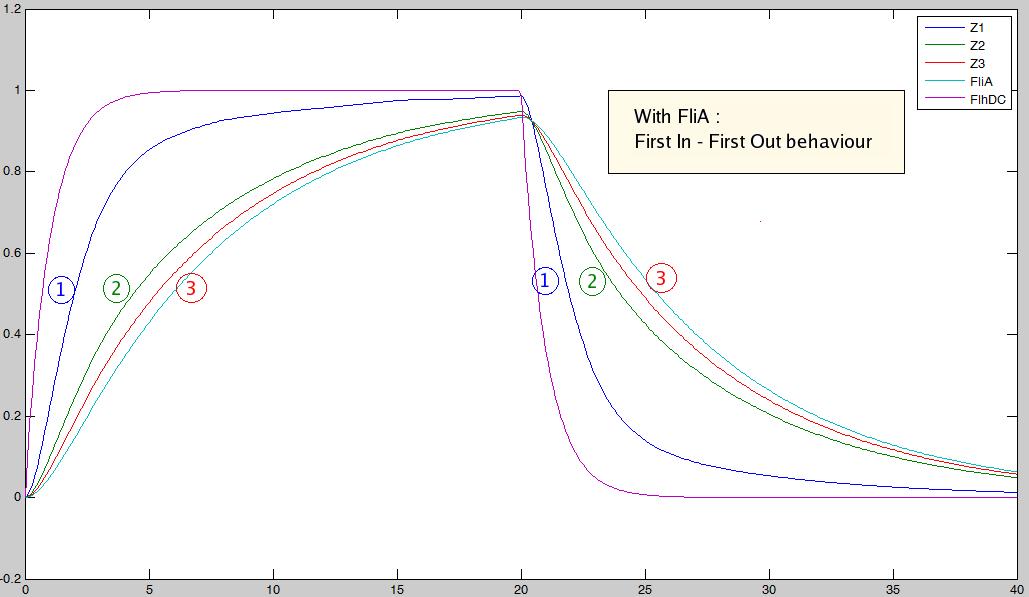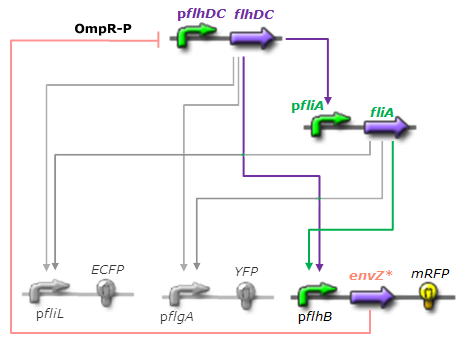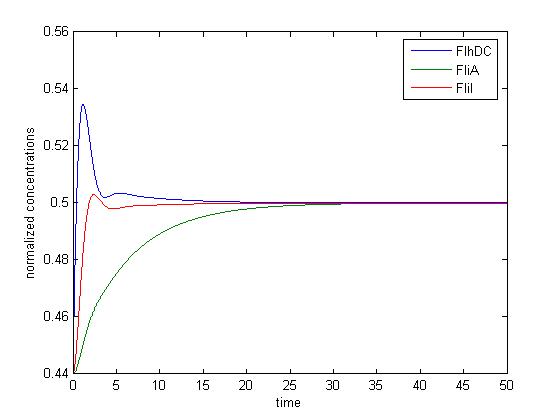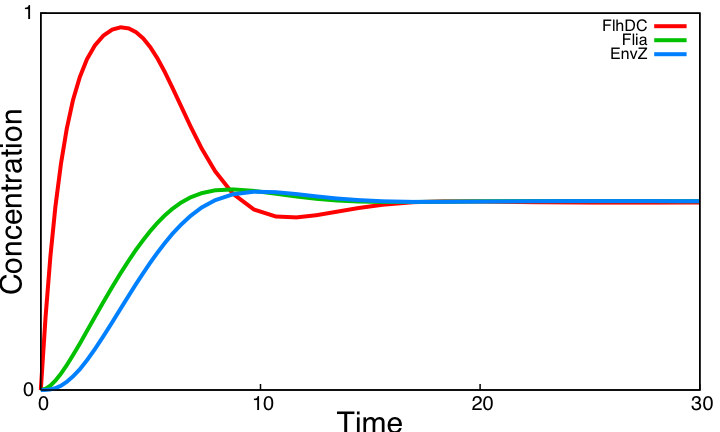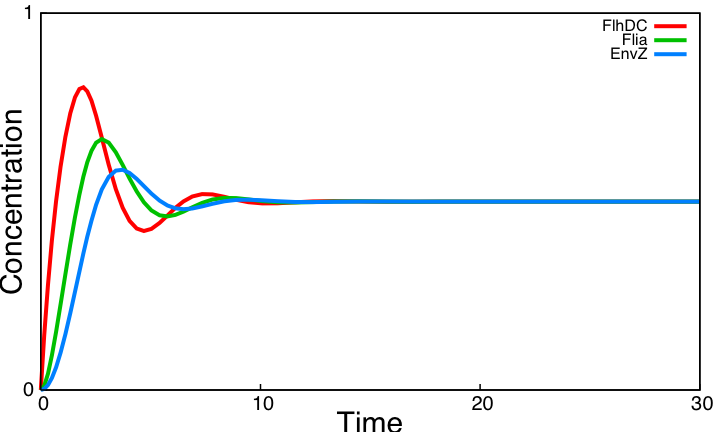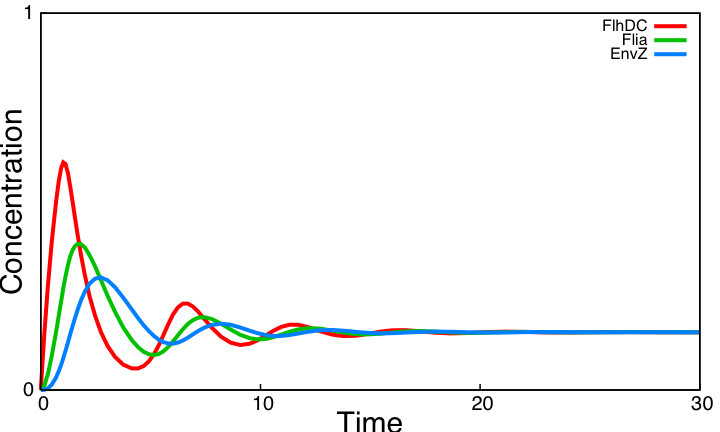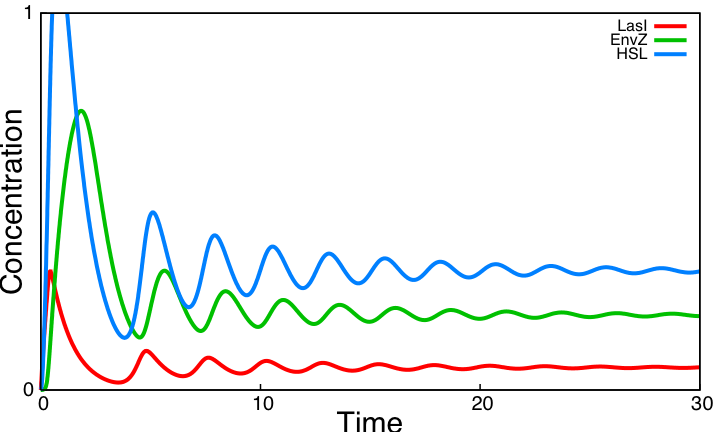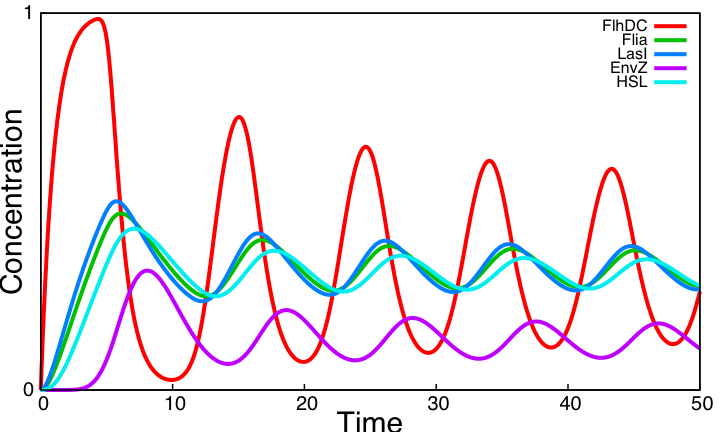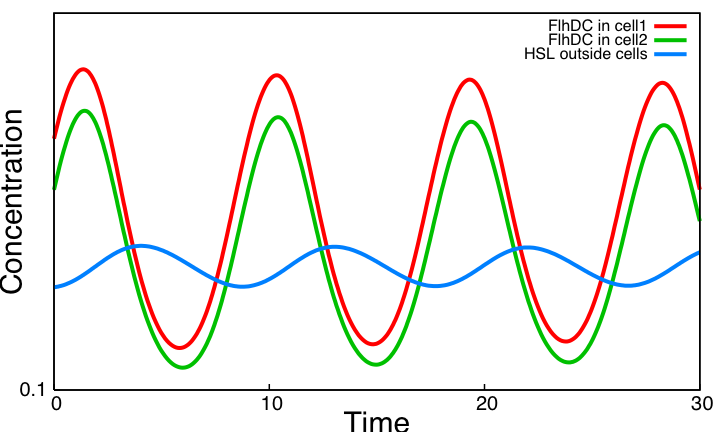Team:Paris/Analysis
From 2008.igem.org
(→Oscillations) |
(→FIFO behaviour) |
||
| (101 intermediate revisions not shown) | |||
| Line 1: | Line 1: | ||
{{Paris/Menu}} | {{Paris/Menu}} | ||
| - | + | {{Paris/Header|Network Analysis}} | |
| - | + | {{Paris/Section_contents_analysis}} | |
| - | + | ||
| - | + | ||
| - | + | ||
| - | + | ||
| - | + | ||
| - | + | ||
| - | + | ||
| - | This page presents the principal results | + | This page presents the principal analytic results derived from the models, corresponding to the [[Team:Paris/Analysis/Design3|genetic networks]] we have designed (FIFO, oscillations, ...), as well as representative simulations' results. |
| + | This has led us to propose some modifications of the initial system, in order to obtain an improved oscillating system. | ||
= FIFO behaviour = | = FIFO behaviour = | ||
| - | + | Here are the network and simulations corresponding to the FIFO aspect : | |
| - | + | As explained [[Team:Paris/Analysis/Design1|here]], the FIFO circuit is made of a main regulator (FlhDC) that activates an intermediary regulator (FliA) and the three output genes Z1, Z2, and Z3 that are activated by the combined effect of the two regulators. | |
| - | + | ||
| - | + | ||
<br> | <br> | ||
| + | [[Image:FIFO.png|460px|left]][[Image:essai_with_fliAbis.jpg|460px|right]] | ||
| + | <br><br><br><br><br><br><br><br><br><br><br><br><br><br><br><br><br><br> | ||
| + | |||
| + | '''The simulation on the right, based on parameter values found in [http://www.ncbi.nlm.nih.gov/pubmed/16729041?ordinalpos=1&itool=EntrezSystem2.PEntrez.Pubmed.Pubmed_ResultsPanel.Pubmed_DefaultReportPanel.Pubmed_RVDocSum Shiraz Kalir ''et al.'' (2004)] directly repoduced a FIFO behaviour: the output genes are inactivated in the same order they are activated.''' | ||
| - | + | ''Go further into'' | |
| - | + | * [[Team:Paris/Analysis/Construction|the model]] | |
| - | + | * [[Team:Paris/Analysis/Math+Sim#FIFO|the mathematical analysis and the simulations]] ? | |
| - | *[[Team:Paris/ | + | |
| - | *[[Team:Paris/ | + | |
= Oscillations = | = Oscillations = | ||
| - | + | The first attempt for an oscillation circuit is implemented as a simple negative feedback loop connecting one output of the FIFO circuit to the input regulator : | |
| - | + | ||
| - | + | ||
| - | + | ||
<br> | <br> | ||
| + | <center> | ||
| + | {| | ||
| + | |- style="background: #ffffff; text-align: center;" | ||
| + | |[[Image:Reseauoscillfinal.png|400px|frameless|Core system]] | ||
| + | |[[Image:steady_state.jpg|300px|right|frameless]] | ||
| + | |- style="background: #ffffff; text-align: center;" | ||
| + | |Core system. | ||
| + | |The core system does not oscillate. | ||
| + | |} | ||
| + | </center> | ||
<br> | <br> | ||
| - | + | <!-- | |
| - | + | '''The first conclusion one can draw is that, with parameters found in the litterature ('biological parameters') the system reaches a steady state and is far from oscillating.''' | |
| - | + | ||
| - | The first conclusion one can draw is that, with parameters found in the litterature ('biological parameters') the system reaches a steady state and is far from oscillating. | + | |
Therefore, we have used the model to infer the modifications (that means the experiments to carry out) that had to be undertaken on the biological system to change its stability. Here are some of the theoretical results of the modifications : | Therefore, we have used the model to infer the modifications (that means the experiments to carry out) that had to be undertaken on the biological system to change its stability. Here are some of the theoretical results of the modifications : | ||
| + | --> | ||
| - | + | From the [[Team:Paris/Analysis/Math+Sim#Oscillations|simulations]] performed with parameters found in the [[Team:Paris/Bibliography|literature]], we conclude that the system reaches a steady state and is far from oscillating ! | |
| + | We evaluate the role of key interactions of the core system by successively simulating altered forms of the system. Curves below display simulations of [[Team:Paris/Analysis/Math+Sim#System_interactions_analysis|3 simple variants]] of the model, none of which producing sustained oscillations. Moreover, a mathematical analysis confirms that [[Team:Paris/Analysis/Math+Sim#Oscillations|the core system cannot produce oscillations]]. These three alternatives are implemented using the programming environment for modeling biochemical systems [http://contraintes.inria.fr/BIOCHAM/ BIOCHAM] (see [[Team:Paris/Modeling/BOB/Simulations/Codes#Alternatives of the core system in BIOCHAM|code]]). | ||
| - | |||
| - | |||
| - | |||
| - | |||
| - | |||
| - | |||
| - | |||
| - | |||
<center> | <center> | ||
| - | <gallery widths="250px"> | + | {| |
| - | Image:Core1.png | + | |- style="background: #ffffff; text-align: center;" |
| - | Image:Core2.png | + | |<gallery widths="250px"> |
| - | Image:Core4.png | + | Image:Core1.png |
| + | Image:Core2.png | ||
| + | Image:Core4.png | ||
</gallery> | </gallery> | ||
| - | + | |- style="background: #ffffff; text-align: center;" | |
| - | + | |Simulations of three variants of the core system | |
| + | |} | ||
</center> | </center> | ||
| - | + | ||
| - | *[[Team:Paris/ | + | ''Read more about: <br> |
| - | *[[Team:Paris/ | + | * [[Team:Paris/Analysis/Construction|the model]] |
| - | *[[Team:Paris/ | + | * [[Team:Paris/Analysis/Math+Sim#Oscillations|the mathematical analysis and the simulations]] |
| + | * [[Team:Paris/Analysis/Math+Sim#System_interactions_analysis|the way we evaluate the interactions present in the core system]]'' | ||
| + | <br> | ||
= System Improvements = | = System Improvements = | ||
| - | |||
| - | + | Our aim is to explore improvements of the core system providing both '''sustained oscillations''' and '''synchronization capabilities'''. We consider [[Team:Paris/Analysis/Construction2|two systems]] based on quorum sensing thus adding at the same time a delay valuable for the oscillations and the ability to synchronize cells via HSL concentration in the environment. | |
| - | + | The first system is inspired by [[Team:Paris/Bibliography|[2]]] and is made of two coupled negative loops. The second one | |
| - | + | is a rewiring of the core system to include quorum sensing and resulting in a single negative loop. | |
| - | + | [[Team:Paris/Analysis/Model2_Analysis|Simulation results]] point out that only this second system delivers sustained oscillations. Moreover we confirm that quorum sensing can indeed be used to synchronize a population of cells. | |
| - | + | ||
<center> | <center> | ||
| - | < | + | <gallery widths="200px"> |
| - | + | Image:System4.png|Damped oscillations with the system based on two coupled negative loops. | |
| - | + | Image:System2.png|Sustained oscillations with the system based on a single negative loop. | |
| - | + | Image:Synchro.png|Synchronization of two population of cells. | |
| - | + | </gallery> | |
| - | + | ||
| - | + | ||
| - | + | ||
| - | + | ||
| - | + | ||
| - | + | ||
| - | + | ||
| - | + | ||
| - | + | ||
| - | + | ||
| - | + | ||
| - | + | ||
| - | + | ||
| - | + | ||
| - | + | ||
| - | + | ||
| - | + | ||
| - | + | ||
| - | + | ||
| - | + | ||
| - | </ | + | |
</center> | </center> | ||
| - | |||
| - | |||
| - | |||
| - | |||
| - | |||
| - | |||
| - | |||
| - | |||
| - | |||
| - | |||
| - | |||
| - | |||
| - | |||
| - | |||
| - | |||
| - | |||
| - | |||
| - | |||
| - | |||
| - | |||
| - | |||
| - | |||
| - | |||
| - | |||
| - | |||
| - | |||
| - | |||
| - | |||
| + | ''Read more about: <br> | ||
| + | * [[Team:Paris/Analysis/Construction2|the description of the two proposed improvements]] | ||
| + | * [[Team:Paris/Analysis/Model2 Analysis|the analysis of these improvements]] | ||
| + | * [[Team:Paris/Analysis/Model2 Analysis#Conclusion|the outcome of our analysis]] | ||
| - | + | {{Paris/Navig|Team:Paris/Analysis}} | |
Latest revision as of 03:50, 30 October 2008
|
Network Analysis
Other pages:
This page presents the principal analytic results derived from the models, corresponding to the genetic networks we have designed (FIFO, oscillations, ...), as well as representative simulations' results. This has led us to propose some modifications of the initial system, in order to obtain an improved oscillating system. FIFO behaviourHere are the network and simulations corresponding to the FIFO aspect : As explained here, the FIFO circuit is made of a main regulator (FlhDC) that activates an intermediary regulator (FliA) and the three output genes Z1, Z2, and Z3 that are activated by the combined effect of the two regulators.
The simulation on the right, based on parameter values found in [http://www.ncbi.nlm.nih.gov/pubmed/16729041?ordinalpos=1&itool=EntrezSystem2.PEntrez.Pubmed.Pubmed_ResultsPanel.Pubmed_DefaultReportPanel.Pubmed_RVDocSum Shiraz Kalir et al. (2004)] directly repoduced a FIFO behaviour: the output genes are inactivated in the same order they are activated. Go further into OscillationsThe first attempt for an oscillation circuit is implemented as a simple negative feedback loop connecting one output of the FIFO circuit to the input regulator :
From the simulations performed with parameters found in the literature, we conclude that the system reaches a steady state and is far from oscillating ! We evaluate the role of key interactions of the core system by successively simulating altered forms of the system. Curves below display simulations of 3 simple variants of the model, none of which producing sustained oscillations. Moreover, a mathematical analysis confirms that the core system cannot produce oscillations. These three alternatives are implemented using the programming environment for modeling biochemical systems [http://contraintes.inria.fr/BIOCHAM/ BIOCHAM] (see code).
System ImprovementsOur aim is to explore improvements of the core system providing both sustained oscillations and synchronization capabilities. We consider two systems based on quorum sensing thus adding at the same time a delay valuable for the oscillations and the ability to synchronize cells via HSL concentration in the environment. The first system is inspired by [2] and is made of two coupled negative loops. The second one is a rewiring of the core system to include quorum sensing and resulting in a single negative loop. Simulation results point out that only this second system delivers sustained oscillations. Moreover we confirm that quorum sensing can indeed be used to synchronize a population of cells.
|
 "
"


